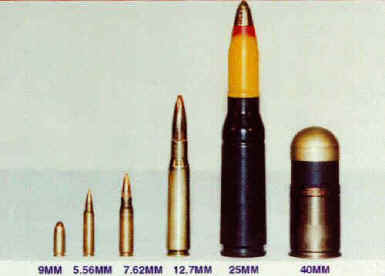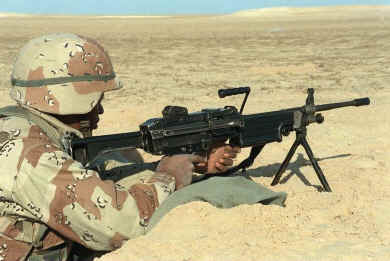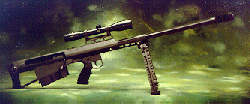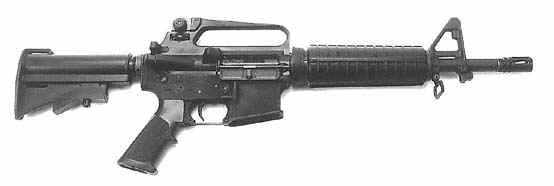
Date 26 Mar 02
From: the Gunny X's Mailbag (a Gunnery Sgt in a Marine line combat unit)
Forwarded by Officer XXX, Camp Pendleton, Calif.
Subject: Small Arms Performance in Afghanistan
Report of American small arms performance from a friend currently assigned
to an infantry unit in Afghanistan:
"The current-issue 62gr 5.56mm (223) round, especially when fired
from the short-barreled, M-4 carbine, is proving itself (once again) to be
woefully inadequate as man stopper. Engagements at all ranges are requiring
multiple, solid hits to permanently bring down enemy soldiers. Penetration is
also sadly deficient. Even light barriers are not perforated by this
rifle/cartridge combination. Troopers all over are switching to the
seventy-seven grain Sierra Matchking (loaded by Black Hills) whenever it can
be found. Its performance on enemy soldiers is not much better, but it does
penetrate barriers. We're fighting fanatics here, and they don't find wimpy
ammunition particularly impressive!
Ed. The Afghans and most armies use the larger 7.62mm
rifle round.
Adding to our challenges, our issue M-9 pistol (Beretta M92F) is proving
itself unreliable. They are constantly breaking. To make matters worse, the
9mm hardball round we use is a joke. It is categorically ineffective as a
fight stopper, even at close range. Some troopers, after numerous, desperate
requests, are now being reissued 1911s! However, the only ones available for
issue are worn out. Magazines are hard to find, and 45ACP ammunition is
scarce.
We are frustrated here that none of the forgoing seems to be of the slightest
concern to people in Washington. It is a damn good thing that we have air
superiority and are not yet heavily engaged on the ground. Inferior weapons
and ammunition are making us all nervous."
Infantry squads need a weapon with more punch.
Currently, the Marine Corps equips each four-man fire team with an M249 5.56mm
light machine gun called the Squad
Automatic Weapon (SAW) (left). Since the other three members
carry 5.56 automatic rifles, the SAW doesn't add much flexibility, despite its
weight of 22lbs (including a 200 ammo box). The SAW should be replaced
with a heavy caliber rifle like the BAR used in the two World Wars.  (below).
This weapon would be designed to provide twice the penetrating power and twice
the range of the 5.56mm rifle.
(below).
This weapon would be designed to provide twice the penetrating power and twice
the range of the 5.56mm rifle.
Such a weapon would be of great value against vehicles, helicopters, and light armor using
high velocity "sabot" rounds, like the tungsten .50
caliber Saboted Light Armor Penetrator (SLAP) round used by the US Army and
Marine Corps. Marine
Colonel Andrew R. Finlayson wrote in the March 1989 edition of the Marine
Corps Gazette: "A 12.7mm armor-piercing,
fin-stabilized, discarding sabot round will go in one end and out the other of
a Light Armor Vehicle without the slightest difficulty." Raufoss rounds
from Norway, also used by the U.S. military, can penetrate the frontal armor of a Soviet BTR-60 armored vehicle at 1000
meters.
These rounds can be fired by the M82A1A
SASR .50 caliber (12.7mm) rifle now in service with American sniper sections. This would be
ideal for infantry squads, except it weighs
35 lbs when loaded, which is too much for a basic infantryman. The smaller
and 10lbs lighter Model 95 (right) could be used, but it is bolt-action and
carries only five rounds. The Army's new
experimental assault rifle (OICW)
can fire a 20mm round, but it's a low-velocity gun not designed for
penetration or range.
A new weapon is needed to fill the gap between the 5.56mm and 12.7mm .50 cal rounds. A 10mm semi-automatic rifle should replace the heavier SAW. This would be simple to design since no new technology is needed. In fact, one manufacturer already sells the THUNDER CAR-10, a 10mm semiautomatic rifle with 11.5" barrel. (left) Such a weapon is needed today to provide rifle squads with real penetration and range to supplement their basic 5.56mm rifles. In addition, fear is a major factor in infantry battles, which explains the comment about "wimpy" M-16s by the Gunny. A 10mm "elephant gun" will be very loud as well as powerful, making those with Russian 7.62mm AK-47 rounds sound wimpy.
Carlton Meyer editorG2mil@Gmail.com
©2002 www.G2mil.com